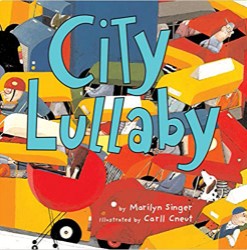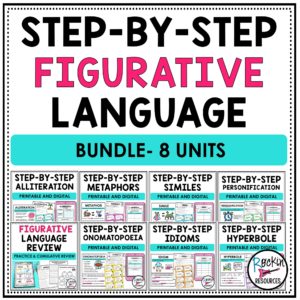Teaching onomatopoeias just got more fun with these mentor texts that feature a variety of human-made and natural sounds. From city streets to nature scenes, students will be entertained by this writing element that involves both visual and auditory senses. Read on for 10 SIZZLING MENTOR TEXTS FOR TEACHING ONOMATOPOEIAS plus some BOOMING teacher tips!
If you’re a fan of the classic Brown Bear, Brown Bear, What Do You See?, then you have GOT to get this book, which is perfect for teaching students about onomatopoeias. With fun illustrations of interesting animals, children are sure to enjoy their lesson about this literary element, while also chanting along with the fun sounds and rhythmic text within the book.
Teacher Tip: You can choose one of the zoo animals from the book to highlight for a science lesson, teaching students about the ecosystem, diet, and behavior of the animal.
One young girl goes outdoors to find out that many animals and plants benefit from the spring rains as they drip and drop, while there are others who don’t quite enjoy the shower as much!
Teacher Tip: Incorporate a lesson on weather by inviting students to help create sounds to describe different weather patterns. Ask them to demonstrate what sounds the wind makes, rumbling storms, and more!
As five mice race towards the finish line, they must figure out ways to overcome the many obstacles they encounter. Neither messy mud nor a grumpy cat can stop these mice! In addition to the entertainment quality, this book contains a bunch of different examples of onomatopoeias.
Teacher Tip: Alter the story so that the mice are riding bikes, and then ask your students to come up with onomatopoeias for the new version! Are there any that would stay the same, or would they all change?
Follow a sleeping baby in a red stroller throughout the city in this rhythmic and rhyming book that features many onomatopoeias. Will the chaotic sounds of the city wake the baby??
Teacher Tip: Think of another setting, like the forest, and come up with onomatopoeias that one would hear there.
This book uses sounds instead of words to tell the story about a young one’s daily routine. With whimsical illustrations to accompany the large variety of onomatopoeia, young readers will be able to recognize the many sounds that they hear every day, from the swooshes of their toothbrush to the splashes of the pool.
Teacher Tip: Ask your students to imitate the sounds of the classroom or cafeteria and then help them spell these sounds out. You can take this activity further by having a list of sounds and a photograph of a familiar location. Then, ask your students to position the onomatopoeia labels in the correct spots on the picture
This nature-themed rain story features a plethora of onomatopoeias, building up from the drip-drops of a sprinkle to the whirling winds of a full-blown storm.
Teacher Tip: Incorporate a lesson on using capital letters versus lowercase to illustrate the different volume of sounds within the story.
These big, noisy machines are working to build a school, and man are they loud! Featuring dump trucks, diggers, rollers, and more, this construction site has all the tools you need to teach your students about onomatopoeias.
Teacher Tip: Since there’s construction everywhere nowadays, ask your students if they can come up with any other sounds commonly heard at construction sites, like the beeps of a truck or the hammering of a nail.
The creators of Jazz ABC present this story of sound that is sure to entice readers through the powerful groove of rhyme and rhythm. World-renowned jazz musician Wynton Marsalis and award-winning illustrator Paul Rogers invite readers on an entertaining journey through a noisy neighborhood full of sound.
Teacher Tip: Use online instruments to help students create new onomatopoeias.
This book is not only great for roller-coaster enthusiasts, but it also can help young readers to confront their roller coaster anxiety! Hearing the coaster zoom, swerve, dip, and dive, your students will be itching to take another ride!
Teacher Tip: Ask your students to imagine that they’re in a theme park. Besides the roller coasters, what other sounds would they hear? The popping of popcorn or maybe the footsteps of others?
Onomatopoeias bring these Sports Illustrated photographs to life as readers see and hear sounds of a football game.
Teacher Tip: Choose another popular sport to examine. What sounds are made in this sport? Are they loud or quiet?
Onomatopoeias are such a fun and exciting literary element to learn about! From the whooshing of roller coasters to the drips and drops of rain, there’s something for every student to savor. Be sure to check out our full list of onomatopoeias for even more sound-filled fun.
Keep Rockin,
SEE SIMILAR BLOGS:


DISCOVER RELATED RESOURCES:
-
Figurative Language Bundle
Original price was: $38.00.$18.99Current price is: $18.99.
SAVE THIS POST ON PINTEREST:

















